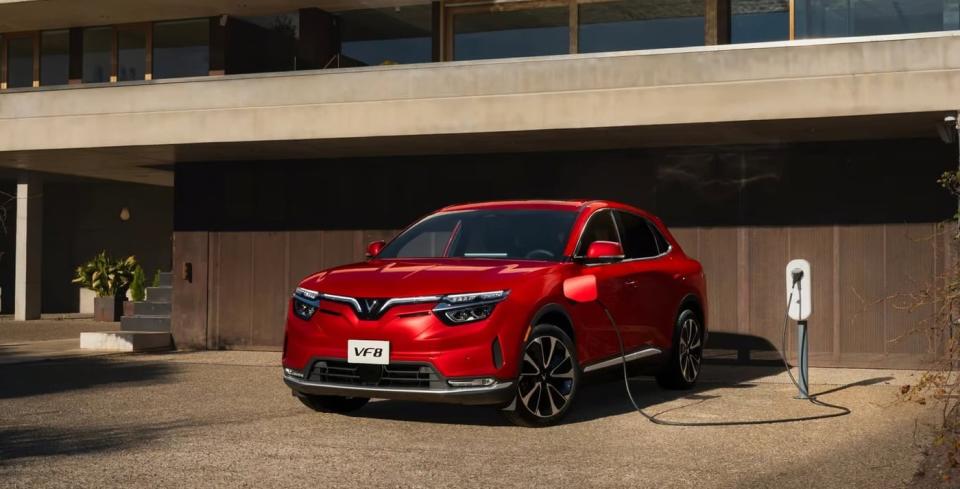
VinFast Auto (NASDAQ: VFS) briefly became one of the hottest electric vehicle stocks on the market when it went public last August through a merger with a special purpose acquisition company (SPAC). Shares of the Vietnamese electric vehicle (EV) maker began trading at $22 and skyrocketed to an all-time high of $82.35 just two weeks later.
But today, VinFast stock is trading for less than $5. Like many other SPAC-backed EV makers, the company was deflated after missing its pre-merger targets and suffering huge losses. Should contrarian investors still buy this troubled EV stock?

Image source: VinFast Auto.
What does VinFast Auto do?
VinFast was founded in 2017 by Vingroup, one of Vietnam’s largest private conglomerates. The company initially licensed and distributed vehicles for General Motors‘ Chevrolet in Vietnam before launching its own sedans, SUVs and crossovers in 2019.
VinFast originally produced gas-powered vehicles, but entered the electric vehicle market in 2021 with its VF series of electric cars, electric scooters and an electric bus. By the end of 2022, the company had fully transitioned to producing electric cars and electric scooters.
VinFast sold just 7,400 vehicles in 2022, all of which were delivered to Vietnam. However, its electric vehicle ambitions attracted the attention of Black Spade Acquisition, a SPAC that believed it could successfully expand into the North American market.
Why did VinFast’s price crash?
In its pre-merger presentation, VinFast claimed it could sell 50,000 EVs by 2023. But it missed that target, delivering just 34,855 EVs and 72,468 electric scooters for the year. More importantly, a whopping 70% of those EV deliveries went to Green SM, the company’s subsidiary, a ride-hailing and leasing company controlled by VinFast’s own CEO Pham Nhat Vuong. It delivered fewer than 1,000 EVs in North America for the year.
In VinFast’s first-quarter report in April, the company claimed it could deliver 100,000 electric vehicles by 2024. That goal, however, hinged on the ability to open its North Carolina factory this year. VinFast began construction on the $4 billion plant last year, which aims to have an annual production capacity of 150,000 vehicles. It had been scheduled to open this month, but the company recently pushed it back to 2028 and lowered its 2024 target to 80,000 deliveries.
That would still represent 130% growth from 2023, but that total will come mostly from deliveries in Vietnam, where the company has come under fire for selling most of its vehicles to its own subsidiary, rather than from deliveries to North America.
VinFast’s future in the U.S. also looks bleak. The company is under investigation by the National Highway Traffic Safety Administration (NHTSA) over a fatal crash in California, is being sued over unpaid rent on its Palo Alto auto showroom, and is facing class-action lawsuits alleging it misled investors with its rosy pre-merger presentation.
The story continues
Even if VinFast finally opens its North Carolina factory in 2028, there’s no guarantee it can differentiate itself in the saturated U.S. market. Its first two EVs for the U.S., the VF 8 mid-size crossover and VF 9 crossover SUV, start at $50,000 and $70,000, respectively. That makes it comparable to Tesla‘s popular Model X.
Is VinFast a contrarian investment?
Despite all these challenges, analysts still expect VinFast’s revenue to rise 108% this year to $2.49 billion. But based on that forecast, the stock is still no bargain, trading at 4 times this year’s revenue. Rivian Automobilewhich one could argue has a much brighter future than VinFast, trades at around 3.5 times this year’s revenue.
VinFast is also still loss-making, ending the latest quarter with just $123 million in cash and $6.65 billion in current liabilities. That’s likely why it’s missing its rent payments and why it didn’t open its North Carolina plant this month.
While VinFast is struggling with these headwinds, I don’t think the stock is a contrarian buy at less than $5. There are simply too many red flags regarding its customer concentration issues in Vietnam and its US expansion plans, so investors should consider other promising EV stocks before betting on VinFast’s speculative growth plans.
Should You Invest $1,000 In VinFast Auto Ltd. Now?
Before you buy shares in VinFast Auto Ltd., you should consider the following:
The Motley Fool Stock Advisor team of analysts has just identified what they think is the 10 best stocks for investors to buy now… and VinFast Auto Ltd. wasn’t one of them. The 10 stocks that made the cut could deliver monster returns in the years to come.
Think about when Nvidia made this list on April 15, 2005… if you had $1,000 invested at the time of our recommendation, you would have $722,626!*
Stock Advisor offers investors an easy-to-follow blueprint for success, including portfolio building guidance, regular analyst updates, and two new stock picks each month. The Stock Advisor has service more than quadrupled the return of the S&P 500 since 2002*.
View the 10 stocks »
*Stock Advisor returns as of July 15, 2024
Leo Sun has no position in any of the stocks mentioned. The Motley Fool has positions in and recommends Tesla. The Motley Fool recommends General Motors and recommends the following options: long January 2025 $25 calls on General Motors. The Motley Fool has a disclosure policy.
Should You Buy VinFast Auto Stock While It’s Below $5? was originally published by The Motley Fool
EMEA Tribune is not involved in this news article, it is provided by our partners and/or the news agencies. Copyright and Credits go to the news agencies, email [email protected] Follow us WhatsApp verified channel


